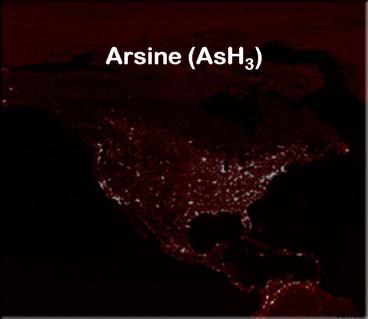Arsine (AsH3) - PowerPoint PPT Presentation
1 / 23
Title:
Arsine (AsH3)
Description:
Oxidizes to arsenic-dihydride intermediate and elemental arsenic, both hemolytic ... EKG changes and dysrhythmias likely. Severe exposure: hypotension ... – PowerPoint PPT presentation
Number of Views:244
Avg rating:3.0/5.0
Title: Arsine (AsH3)
1
Arsine (AsH3)
2
Arsine - Overview
- Highly poisonous, colorless, nonirritating,
flammable gas - Mild garlic odor at 0.5 ppm
- 2.5 times heavier than air
- Soluble in water
- Used commercially
- organic synthesis
- processing of electronic components
3
Arsine - Toxicity
- Most acutely toxic form of arsenic
- Preferentially binds to hemoglobin
- Oxidizes to arsenic-dihydride intermediate and
elemental arsenic, both hemolytic agents - Direct and severe effect on the liver, spleen,
kidneys, lungs, and other organs
4
Arsine - Toxicity
- Major route of toxicity in inhalation
- Children may be more vulnerable
- Acute poisoning accidental
- OSHA standard 0.05 ppm (0.2mg/m3)
- NIOSH standard 0.002 mg/m3
- Mean lethal dose is unkown, but 250 ppm is
instantly lethal
5
Protective Equipment
- Chemical protective clothing not required
- Respiratory protection options
- Positive-pressure, self-contained apparatus
(SCBA) - Supplied-air respirator with full facepiece
- Gas mask with a chin-style, front or back mounted
canister
6
Detection
- Variety of arsine monitors and gas sensors
available commercially - Can detect arsine at levels as low as 0.05 ppm
7
Decontamination
- For arsine gas only, additional decontamination
is not required - Remove victims immediately from exposure site to
fresh air - Exposure to solid arsenic salt may require
further decontamination
8
Signs and Symptoms
- Characteristic features
- Abdominal pain
- Bloody urine
- Jaundice
9
Signs and Symptoms
- Initial Symptoms
- Headache, thirst, shivering, malaise, weakness,
dizziness, dyspnea, abdominal and back pain,
hepatomegaly, nausea and vomiting - Development usually noted 2 to 24 hours post
exposure - Garlicky odor on the breath
10
Signs and Symptoms
- EKG changes and dysrhythmias likely
- Severe exposure hypotension
- CNS disorders can develop days after severe
exposure - Peripheral nerve damage 1 to 2 weeks after
exposure
11
Signs and Symptoms
- Hematuria
- Light to dark red
- 4-6 hours after exposure
- Jaundice 12 to 48 hours later
- Hemolysis continues up to 4 days
- Unusual bronze skin discoloration
12
Signs and Symptoms
- Hemoglobin destruction
- Clog kidneys
- Produce acute tubular destruction and renal
failure - Other toxic effects
- Lung, liver and heart damage
- Frostbite injury possible
13
Laboratory
- Evident in peripheral smear
- Varying size/shape of red blood cells
- Red-cell fragments
- Heinz bodies
- Ghost cells
- Cell component affinity for basic dyes
14
Laboratory
- Bone marrow unremarkable
- Coombs and Ham tests negative
- RBC fragility is normal
15
Laboratory
- Urinalysis myoglobinuria
- Large amounts of protein and free hemoglobin
- Brown, red, orange, or greenish urine
- Elevated serum globulin, CPK and liver enzymes
- Prolonged prothrombin time
16
Treatment
- Basic first aid for victims
- Prompt medical attention
- No specific antidote
- Supportive of respiratory, vascular and renal
function - Oxygen and fluids
- Bronchodilators
- Racemic epinephrine for children
17
Treatment
- NIOSH treatment guidelines
- Blood exchange transfusion
- Administer dimercaprol BAL
- BAL standard dosing 3-5 mg/kg IM q4hr for 4
doses - May not be effective in acute toxic events
18
Treatment
- Hemolysis
- Start urinary alkalinization
- Monitor serum electrolytes, Ca, BUN,
creatinine, hemoglobin and hematocrit - Start dialysis
- Consider BAL if suspicious of toxic arsenic
levels
19
Long-Term Medical Sequelae
- Anemia may persist several weeks
- Polyneuropathy and altered mental status reported
1-6 months after poisoning - Arsenic compounds are known human carcinogens
- Potential teratogenic agent
20
Environmental Sequelae
- Environmental effects not reported
- Exposure to light
- Moist arsine decomposes quickly
- Deposits shiny black arsenic
21
Summary
- Potential for terrorist use
- Lethal
- Can be dispersed as gas
22
Summary
- Most acutely toxic form of arsenic
- Preferentially binds to hemoglobin
- Oxidizes to arsenic-dihydride intermediate and
elemental arsenic - Characteristic Features
- Abdominal pain, bloody urine, jaundice w/ severe
hemolytic anemia
23
Summary
- Hematuria
- Light to dark red w/in 4-6 hours
- Jaundice w/in 12-48 hours
- Acute tubular destruction and renal failure
- No antidote
- Supportive treatment
- Dialysis































